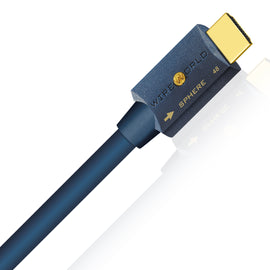QUESTION: How can an upgrade cable improve streaming fidelity when Ethernet already transfers files perfectly?
ANSWER: Normal Ethernet file transfers don’t lose any data because they are transmitted on TCP/IP, a protocol with an error correction system that automatically resends any missing information until the file is complete. TCP/IP is extremely reliable, but it is not used for streaming because the resend function would interrupt the music. Streaming runs on UDP/IP, which loses information because it cannot replace missing data by resending it. UDP/IP only has the ability to reduce errors and this is used to fill in data dropouts that would otherwise cause annoying clicks in the sound. Streamed music and video signals have only one chance to get through, so a cable with better waveform fidelity and lower noise will reduce errors, thereby preserving more of the original information.
Q: How can a short Wireworld Ethernet cable improve fidelity when the signal has already passed through a long length of lower grade cable?
A: The last link of an Ethernet connection is far more critical than the in-wall cable. One reason for this is the vibration from speakers, which adds triboelectric noise and modulation distortion to the signal. Also, impedance variations within the connectors and cable are especially problematic at the end of the signal path, where they cause signal reflections. Wireworld Ethernet cables work so well because they minimize those problems to deliver cleaner waveforms that are much easier for the streamer to read accurately.
Q: What other problems can Tite-Shield technology solve?
A: Conventional round high speed Ethernet cables are stiff and require special tools to assemble. They also can’t bend around sharp turns without losing performance and any excess length creates large coils. In contrast, Wireworld Ethernet cables are flat, flexible designs that fit under carpet, bend around corners, coil effortlessly and can be assembled with a simple wire cutter or knife.

Q: What makes the Tite-Shield design better than the standard design used in other Ethernet cables?
A: Category 8 performance is difficult to achieve with conventional shielded twisted pair designs. The primary challenge is minimizing crosstalk (mixing) between the four signal channels. To control crosstalk, conventional cables twist the four pairs of conductors and use one foil shield on each pair. An overall two-layer shield reduces outside interference. Twisting the conductors reduces crosstalk, but it also tends to make the conductor lengths uneven, which causes timing errors called skew. Furthermore, conventional twisted pair high speed Ethernet cables are also quite stiff.
The conductors in Wireworld’s Tite-Shield design are not twisted at all. Instead, they are arranged as four parallel channels with a dense three-layer shield on each conductor pair. These shields isolate the four channels so effectively that twisting is not required and conductor length differences are eliminated. This patent pending flat design minimizes both crosstalk and skew, providing leading edge performance, simplified assembly and excellent installation flexibility. The cables also utilize Wireworld’s proprietary Composilex® 2 insulation to minimize triboelectric noise, which is especially helpful when used in vibration prone home theater environments.


